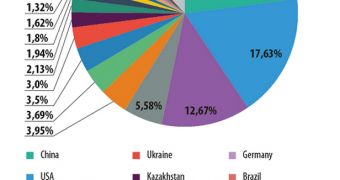IT security giant Kaspersky has released its spam report for 2013. The figures show that the volume of spam in email traffic has decreased by 2.5% compared to the previous year, dropping to 69.6%. Almost 75% of spam emails sent out last year were less than 1 Kb in size.
As far as spam sources are concerned, China remains number one, accounting for close to 23% of all spam traffic. China is followed by the United States (17.63%), Korea (12.67%) and Taiwan (5.58%).
For the first time, Canada has made it to the top 20 spam sources. On average, the country accounted for 1.31% of spam traffic. It's worth noting that Canada is currently preparing an anti-spam law that will come into force on July 1.
If we look at continents, Asia was responsible for well over half of the unsolicited messages sent out last year.
Experts found that 3.2% of all email traffic contained malicious attachments. This represents a 0.2% decrease compared to 2012. Most of the pieces of malware distributed via email have been designed to steal sensitive information from infected computers.
When it comes to phishing, social networking sites remain the most targeted (32%), followed by search engines (16%), financial organizations (15%), and email and instant messaging services (12%).
“As we see fewer legal commercial offers in spam, the more we see fraudulent and malicious messages appearing,” Kaspersky experts noted in the report.
“Previously cybercriminals could rely on exploiting the trust of unwary users, but now they face a new generation of IT-savvy targets. That has prompted them to adopt new tactics, such as sending out malicious attachments in the guises of antivirus updates.”
For additional details and examples of the spam emails doing the rounds in 2013, check out Kaspersky’s complete spam report.

 14 DAY TRIAL //
14 DAY TRIAL //